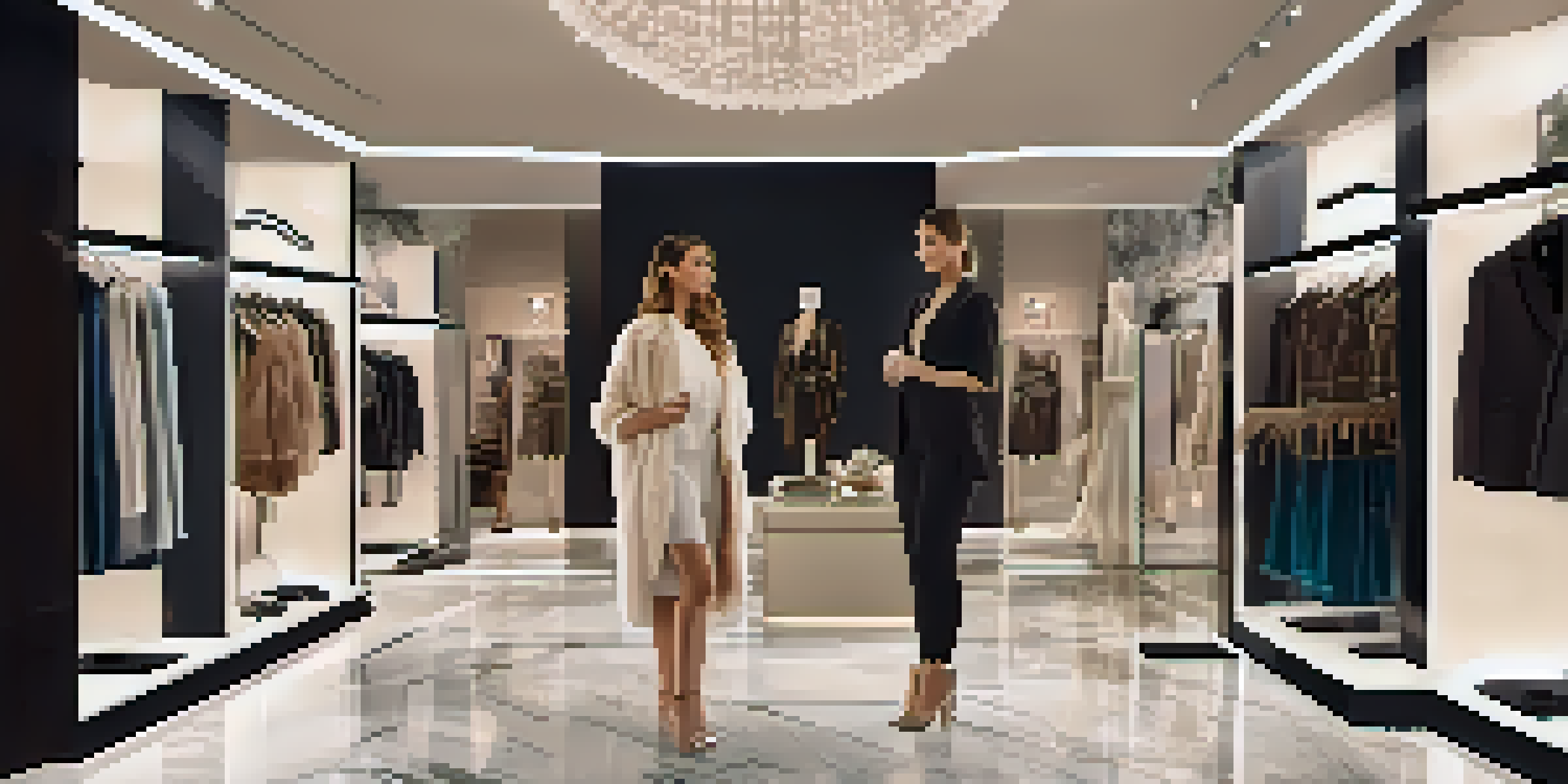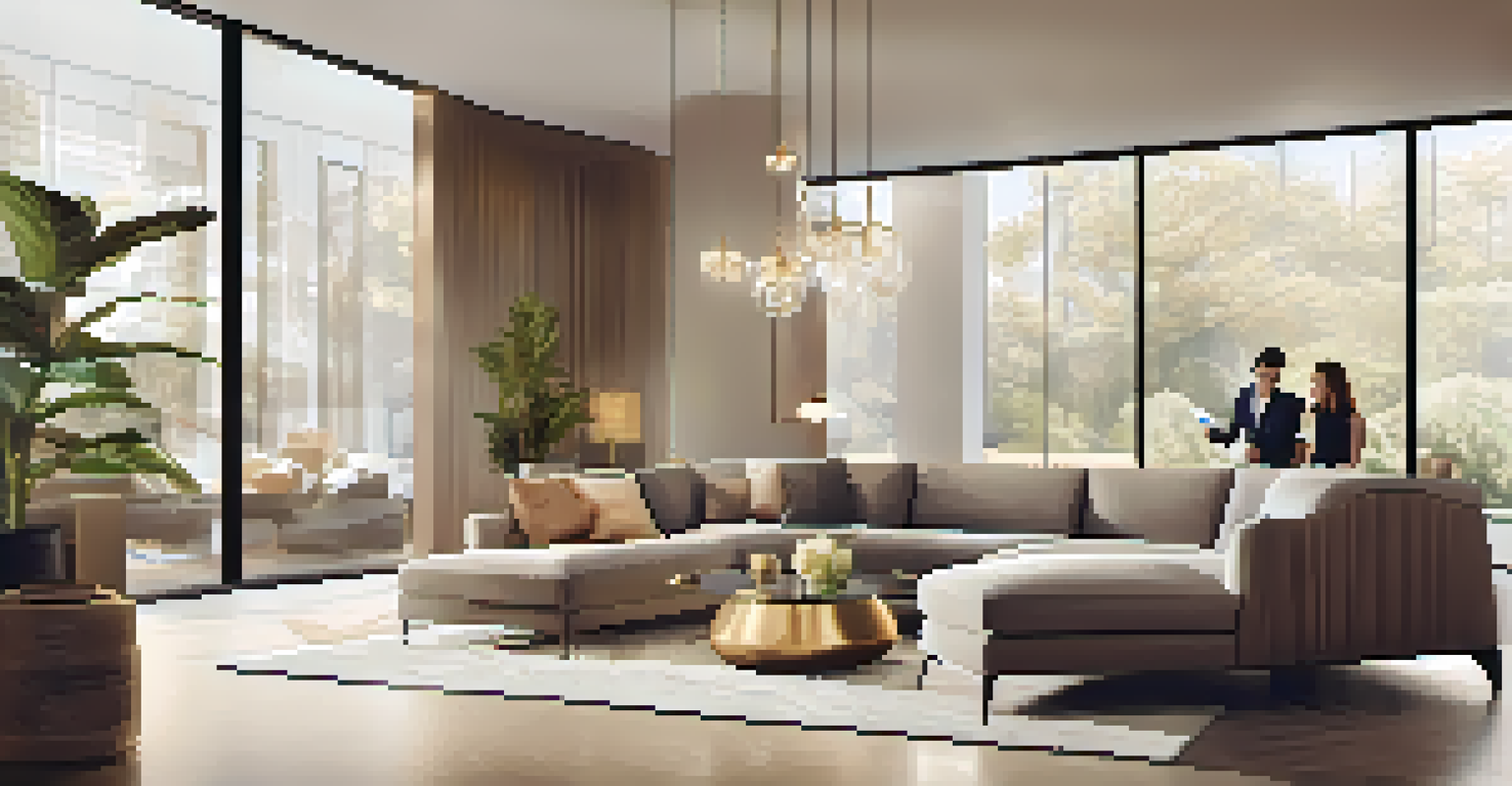Augmented Reality: Enhancing Luxury Shopping Experiences

What is Augmented Reality in Luxury Retail?
Augmented Reality (AR) is a technology that overlays digital content onto the real world, enhancing how we perceive our environment. In luxury retail, it creates immersive experiences that allow customers to visualize products in a whole new way. For example, imagine trying on a designer handbag virtually before making a purchase, giving you a sense of how it fits your style.
Augmented reality is the bridge between the digital and the physical world, enhancing the shopping experience in ways we never thought possible.
This innovative technology bridges the gap between online and offline shopping, offering a unique blend of both experiences. Customers can explore products in their own space, making the shopping journey not just about buying but about engaging with the brand. It's this added layer of interaction that sets luxury shopping apart in today's digital age.
As AR technology continues to advance, its applications in luxury retail are becoming increasingly sophisticated. From virtual fitting rooms to interactive showrooms, the possibilities are endless. Luxury brands that adopt AR are not just keeping up with trends—they're redefining the standard for customer experience.
The Role of AR in Personalized Shopping Experiences
Personalization is key in luxury retail, and AR takes it to the next level. By utilizing AR, brands can tailor the shopping experience to individual preferences, making customers feel valued. For instance, a virtual stylist might suggest outfits based on your previous purchases or even your body type, ensuring you find something that suits you perfectly.

This technology allows consumers to visualize how products will fit into their lives, creating a connection beyond the sale. Imagine seeing how a piece of furniture looks in your living room or how a watch complements your outfit—all from the comfort of your home. This kind of tailored experience fosters loyalty and increases the likelihood of making a purchase.
AR Transforms Luxury Retail
Augmented Reality enhances the luxury shopping experience by allowing customers to visualize products in their environment, bridging the gap between online and offline shopping.
Moreover, the data collected from AR interactions can help brands refine their offerings, ensuring they meet the evolving tastes of their clientele. This cycle of feedback not only enhances the shopping experience but also strengthens the relationship between the customer and the brand.
Enhancing Customer Engagement through AR
Engagement is crucial in luxury retail, and AR provides an interactive platform that captivates customers. Instead of passively browsing, shoppers can actively participate in their shopping journey, making it more memorable. For instance, a luxury beauty brand might offer an AR feature that lets customers try on makeup virtually, encouraging them to experiment and discover new products.
In the luxury market, creating memorable experiences is as important as the products themselves. Augmented reality is revolutionizing how we connect with customers.
This dynamic interaction not only increases time spent with the brand but also enhances emotional connections. When customers can visualize themselves using a product in real-time, they are more likely to feel a sense of ownership before even making a purchase. This emotional engagement is what luxury brands thrive on.
Additionally, AR can facilitate social sharing. Shoppers can capture their virtual experiences and share them on social media, promoting the brand organically. This word-of-mouth marketing is invaluable, especially within luxury circles, where recommendations carry significant weight.
AR as a Tool for Innovative Product Presentation
Luxury brands are renowned for their exquisite presentation, and AR elevates this to new heights. Through AR, products can be showcased in 3D, allowing customers to explore every detail from different angles. This not only enhances the visual appeal but also helps potential buyers understand the craftsmanship that goes into luxury items.
For example, a high-end watch brand might allow users to interact with a virtual model of their latest timepiece, examining the intricate mechanics and design features up close. This immersive experience can significantly influence purchasing decisions, showcasing the product's value in a way traditional images simply cannot.
Personalized Shopping with AR
AR technology enables luxury brands to create tailored shopping experiences, fostering customer loyalty by aligning products with individual preferences.
Moreover, AR can create a narrative around products, transforming a simple viewing into an interactive story. Customers might access the history of a luxury brand or learn about the artisans behind a product, deepening their appreciation and desire to own such a unique item.
Overcoming Barriers to AR Adoption in Luxury Retail
Despite its potential, some luxury retailers hesitate to adopt AR technology due to perceived barriers. Concerns about cost, complexity, and integration with existing systems often hold brands back. However, as technology advances, AR solutions are becoming more accessible and affordable, making it easier for brands to implement these tools.
It's also essential for luxury brands to recognize that the investment in AR can yield significant returns. As customers increasingly seek interactive and unique shopping experiences, failing to adopt AR could mean losing out to competitors. Brands should view AR not as an expense but as a strategic investment in customer engagement and brand loyalty.
Education and training play a crucial role in overcoming these barriers. By providing staff with the necessary skills and knowledge to utilize AR technology effectively, brands can ensure a smooth transition. This commitment to innovation will ultimately enhance the overall shopping experience, reinforcing the brand's status in the luxury market.
The Future of AR in Luxury Shopping
As technology continues to evolve, the future of AR in luxury shopping looks incredibly promising. We can expect even more sophisticated applications that integrate seamlessly with other technologies, such as artificial intelligence (AI) and machine learning. This evolution will lead to hyper-personalized experiences that anticipate customer preferences before they even voice them.
Imagine walking into a luxury store where AR instantly recognizes you and presents tailored recommendations based on your past interactions. This level of personalization and convenience could redefine how luxury shopping is experienced. The emphasis will shift from merely selling products to creating unforgettable experiences that resonate with customers.
Future of AR in Luxury Shopping
The future of AR in luxury retail promises hyper-personalized experiences, with brands that adopt this technology early setting new standards for customer engagement.
Moreover, as AR becomes more mainstream, luxury brands that embrace this technology early on will set themselves apart. They will establish a reputation for innovation and customer-centric experiences, attracting a new generation of shoppers who value both luxury and technological sophistication.
Conclusion: Embracing AR for a Luxurious Future
In conclusion, augmented reality is not just a trend; it's a revolutionary force shaping the future of luxury shopping. By enhancing personalization, engagement, and product presentation, AR allows brands to create unforgettable experiences for their customers. It's an opportunity for luxury retailers to elevate their offerings and stay relevant in an increasingly digital world.
As we move forward, those who embrace AR will not only enhance their customer experiences but also foster deeper connections with their clientele. The luxury market is evolving, and AR is at the forefront of this transformation, making shopping not just a transaction but a memorable journey.

Ultimately, the brands that successfully integrate AR into their shopping experiences will set the standard for luxury retail. By prioritizing innovation and customer engagement, they will not only thrive but also redefine what luxury shopping means in the modern age.